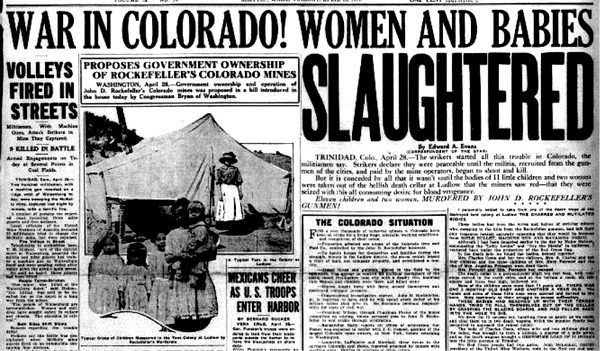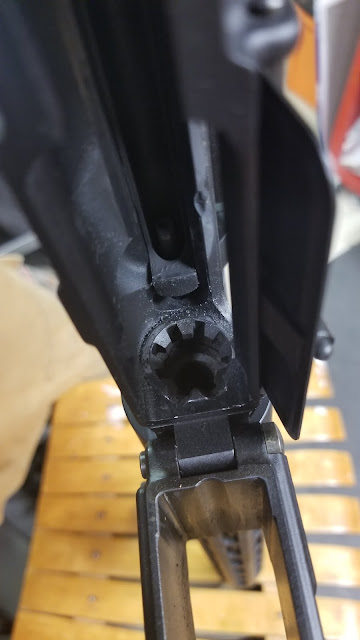The Colorado Coalfield War
Introduction:
Because today is Labor Day in the US, I wanted to use today to look at a historical event related to organized labor in the US. The late 19th and early 20th centuries ushered in the dawn of the labor movement. With the Industrial revolution having tamed much of the west and created a massive new class of worker, the United States as a nation was grappling with where this new class fit into society. These new industrial workers worked long, hard hours is often extremely unsafe conditions. There were no organizations or regulations focused on safety or a worker's wellbeing, so much of this new labor class was mistreated or abused by company owners and their foremen. This lead to workers organizing into unions. These unions allowed workers to band together to bargain for collective concessions from company owners and industry leaders. Union efforts led to things we see as normal today such as weekends or the 40-hour work week.
Because of their origins, labor organizations and industry have had a very adversarial relationship throughout history. This history goes beyond strikes and walkouts. In the later 19th and early 20th centuries, it was not uncommon for there to be open violent and bloody clashes between union workers and strikebreakers. One such example of this labor-related violence, and the topic of todays blog, is the Colorado Coalfield War.
Details:
The Colorado Coalfield war began as a traditional union strike by coal miners of the Colorado Fuel and Iron, a Rockefeller company. The workers found that the company was not enforcing a recently passed safety regulation the required better ventilation down in the mines. The company responded to the strike by evicting thousands of workers and their families from the company-owned housing that they were allotted and forcing the workers to live out of union-supplied tents.
A couple months into the strike is when violence began to erupt. Isolated murders began occurring on both sides between local law enforcement and the strikers, and all out conflict arose when the Colorado governor declared martial law and brings in the national guard. These Guardsman brought with them machine guns and rifles to oppose the strikers. For much of this time, the union was against the stikers being armed, for fear that conflict could escalate. The National guardsman were essentially there to support the company's efforts to crush the strike.
Everything changed, however, in April of 1914, with the Ludlow Massacre. The tent colony of Ludlow was one of the largest of the strike. Strikers and their families were living in these tent colonies following their eviction from their company housing. In April of 1914, an anti-striker militia, along with support from the Colorado national guard, used their machine guns to open up on the tent colony. This resulted in the deaths of 21 people in the camp, 12 of them being children.
 |
| Source |
This massacre was the flashpoint for the conflict. Any opposition to armament by the union was gone, and over the next 10 days, strikers engaged in several attacks along a 175 mile frontline. Strikers engaged in skirmishes with militia members and the national guard, resulting in ~20 strikers killed and over 37 militia or national guard troops killed.
The fighting ended after the federal government stepped in to disarm both sides of the conflict. Woodrow Wilson, the president a the time, was seen as generally pro-labor, so a peaceful resolution to the conflict was preferred over a heavy-handed one. The strike itself ended after fizzling out at the end of 1914, the union having run out of money.
In the aftermath of the conflict and strike, Rockefeller began some labor reforms in his coal mines. These reforms sought to improve employee representation within the company. These reforms also included great moral and social support for the miners, resulting in improved labor relations.
Conclusion:
On this Labor day, I felt that this story is particularly relevant to the idea of gun rights. Whether or not you agree with what is being demanded, people have an inherent right to stand up for what they believe in. The story also highlights the importance of winning the moral fight as well as the physical one. Had the Guardsman and strikebreakers not committed such a heinous act of violence against the strikers, the conflict would have merely been a matter of waiting the strikers out until the money ran dry. Instead, they enflamed the strikers' push for change and heightened the temperature of the conflict.
Armed resistance against the state is an American tradition, and to resist those in power in the name of a moral good is admirable. No matter your opinions on unions in the 21st century, the story of the Colorado Coalfield War is one of righteous resistance in the name of a moral good.


Comments
Post a Comment